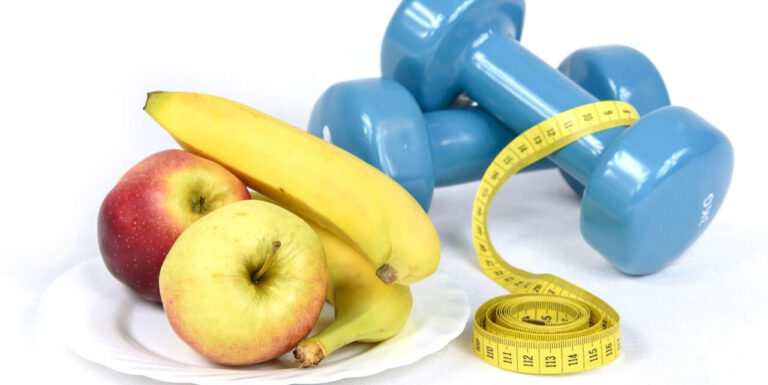Free Calorie Tracker Spreadsheet [Google Sheets]
Are you looking for a way to track your calories and stay within your daily calorie targets?
If so, then you will want to check out this free calorie tracker spreadsheet, that I am about to share with you in this article.
This spreadsheet is available in Google Sheet format, and it allows you to track your daily calorie intake, as well as macronutrients – protein, fat and carbohydrates. It also allows you to set daily calorie goals, track calories burned from exercise and see at a glance how many calories you have left to consume for the day.
In this article, I will share with you how to use this daily food log template, and how to make the most of it.
GET THE SPREADSHEET
Free calorie tracker spreadsheet – just click on the link to make your editable copy in Google Sheets.
Table of Contents:
- What is Calorie Counting Diet?
- Why Should You Count Calories?
- How Do You Track Calories On a Spreadsheet?
- How To Get Calorie Tracker Spreadsheet?
- How to Use Calorie Tracker Spreadsheet?
- Frequently Asked Questions About Calorie Counter Tool
What is Calorie Counting Diet?
A calorie counting diet is a way of eating where you track the number of calories you consume each day. The idea behind it is that by being aware of the number of calories you are consuming, you can make better choices about the foods you eat and ultimately reach your fitness goal, whether that be to lose body fat, gain muscle or simply maintain your current weight.
We all burn a certain number of calories per day, depending on our age, weight, height and activity level. This is known as our total daily energy expenditure (TDEE).
When we eat more calories than we burn, we gain weight. When we eat fewer calories than we burn, we lose weight. And when we eat about the same number of calories that we burn, we maintain our weight.
You can start with the calorie counting diet by setting a daily calorie target, which you can then track using an app or calorie counter spreadsheet like the one I am sharing with you in this article.
You can also take it a step further by creating a macro meal plan – that is, a plan that includes the specific amount of protein, fat and carbohydrates you should eat each day.
Why Should You Count Calories?
There are a number of reasons why you might want to start counting calories.
Maybe you have a specific fitness goal in mind, such as weight loss or building muscle. Or maybe you just want to be more aware of the food you are eating and make better choices about your diet.
Whatever your reason, calorie counting can be a helpful tool to reach your goal.
How Do You Track Calories On a Spreadsheet?
The way you track calories on a spreadsheet is by inputting the foods you eat into the spreadsheet, along with the portion size.
The spreadsheet should have a database of foods, with the nutritional information of each food.
This would allow you to simply select the food you ate from the drop-down menu, and then input the portion size.
The spreadsheet would then calculate the calorie count and macros you consumed.
This is exactly how the calorie counter spreadsheet I am sharing with you works.
Of course, you can also track your daily calorie intake by inputting your meals into an app like MyFitnessPal.
However, I personally find using a spreadsheet to be a better way to track my calories, as it ensures that the nutrition facts of each food are accurate.
I am saying this after being a user of MyFitnessPal for many years. I regularly found discrepancies between the nutritional information on MyFitnessPal and that of the food label. The reason for that is that a lot of the information on MyFitnessPal is crowdsourced, which means that it is not always accurate. This is one of the main reasons you could find yourself hitting macros but not calories.
How To Get Calorie Tracker Spreadsheet?
GET THE SPREADSHEET
Free calorie tracker spreadsheet – just click on the link to make your own editable copy in Google Sheets.
Once you click on the link and hit the “Make a copy” button, it will create an editable version of the spreadsheet in your own Google Drive.
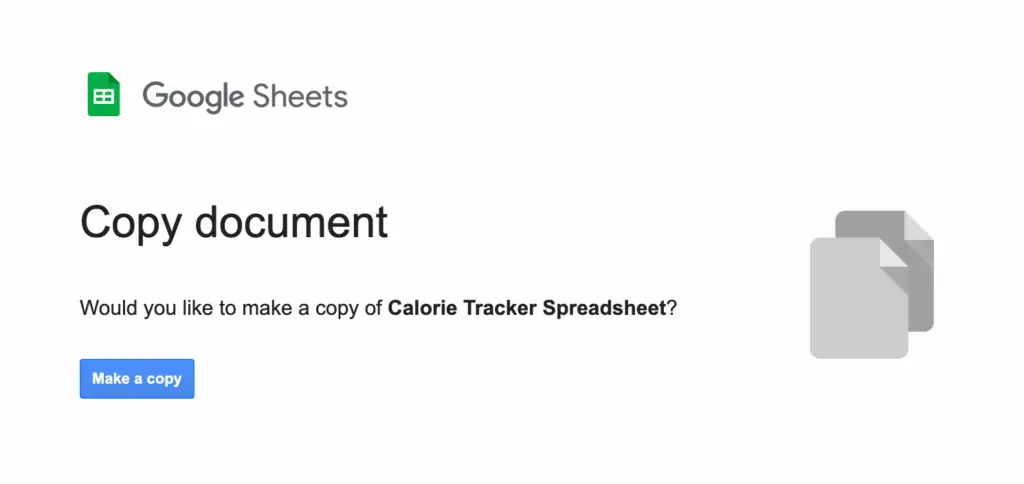
How to Use Calorie Tracker Spreadsheet?
Now, let’s get into how to use the calorie tracking tool.
Calorie Tracker Basics
The calorie counter spreadsheet I am sharing with you in this article has the following tabs:
- Calorie & Macro Tracker: This is where you will enter your meals and snacks for the day.
- Protein (Data), Carbs (Data), Veggies (Data), Fruits (Data), Fats (Data), Condiments (Data): All these sheets contain the nutritional information of each food item, and some formulas.
NOTE
Throughout the spreadsheet, I have coloured cells in light yellow, light blue and light green colours.
The meaning behind this is:
- Light yellow cells = input cells (cells where you will enter your data).
- Light blue and light green cells = output cells (cells that show the results of the formulas).
First, you need to input your daily calorie target under the “Target Calories (Kcal)” cell.
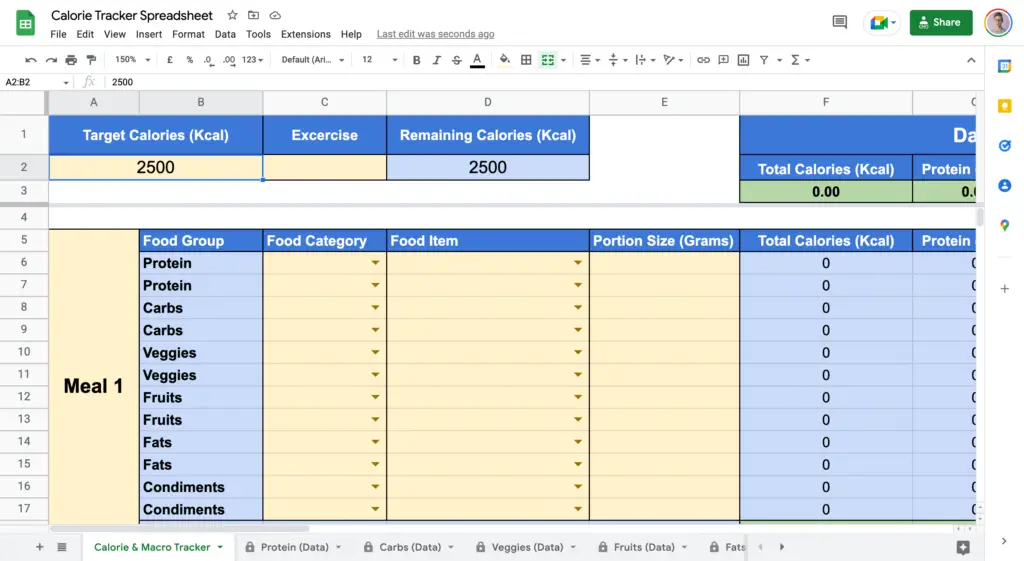
As you track your calories, by the end of the day try to be close to your calorie target.
You will notice that the “Remaining Calories (Kcal)” cell automatically calculates how many calories you have left for the day.
Aim to be within 50 calories (on both ends) of your target.
If you surpass that number, the cell “Remaining Calories (Kcal)” will turn red, to indicate that you went over your calorie target.
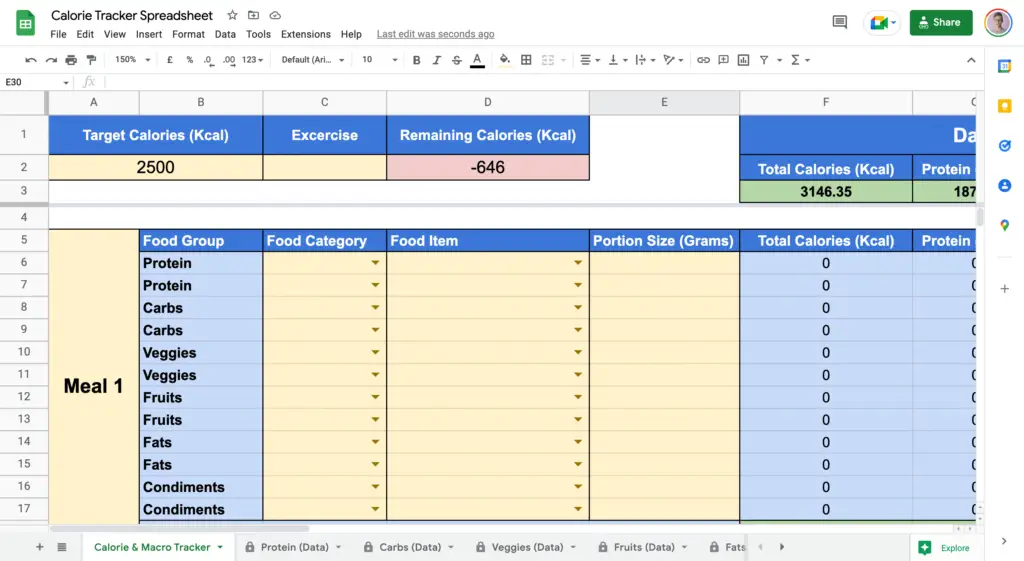
If you don’t know what your calorie target should be, you can use a TDEE calculator to find out, then depending on your goal (lose weight, gain muscle or maintain weight), you should just the calorie intake target.
If you want to go a step further and track your macros you can use a macro calculator. I also recommend you check out these articles on how to calculate your calorie macros specifically for the cutting or lean bulking phase.
Now, let’s go through the workflow of adding meals and snacks to the spreadsheet:
- First, next to the food group you need to select the food category from the drop-down.
- After that, select appropriate food items from the next drop-down on the right.
- Then you will need to enter the portion size in grams.
The nutritional information for that particular food will be automatically populated in the cells on the right side.
I typically structure my meals using the following method:
- Think of which food item you would like to eat from each of the macronutrients. If you are not familiar with which foods contain which macros, here’s a macronutrient cheat sheet.
- Form meals around those food items.
For example, when coming up with lunch, I might want salmon as the source of protein and healthy fats, sweet potato as a carbohydrate source, and broccoli as my vegetable.
How to Track Calories for Meals and Snacks
To track calories in a meal or a snack, you need to do the following.
First, on the right side of the “Food Group” column, select the food category from the drop-down.

Then, select the appropriate food items from the next drop-down on the right.
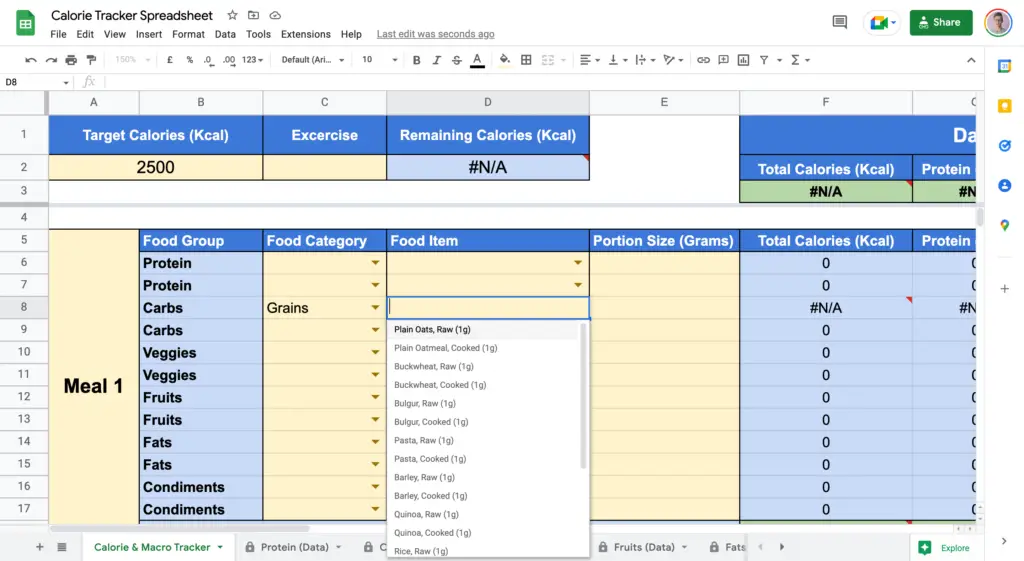
After that, enter the portion size in grams.
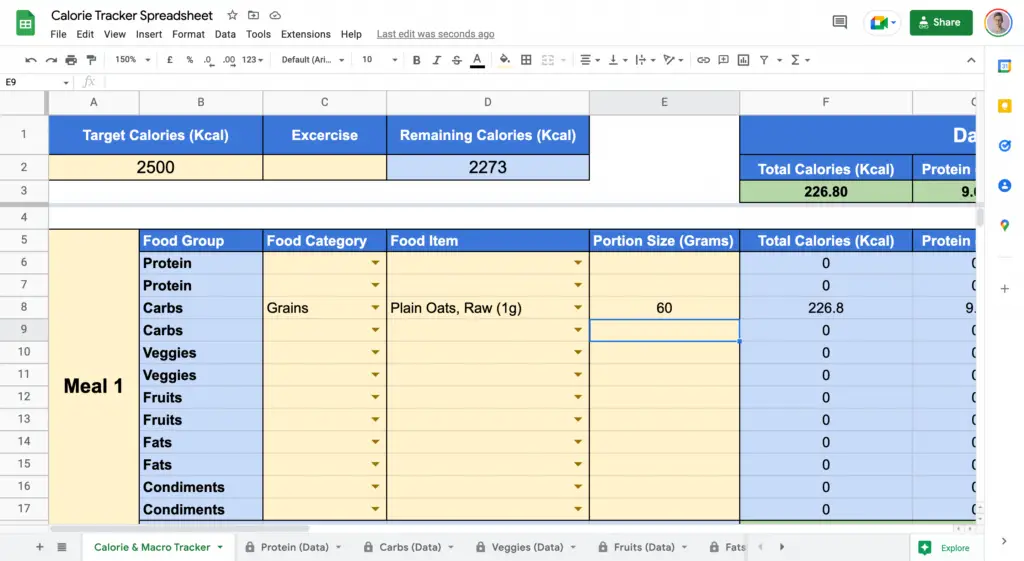
The nutrition tracker spreadsheet will automatically populate the information regarding calories, protein, carbs, and fats for that particular food in the cells on the right side.
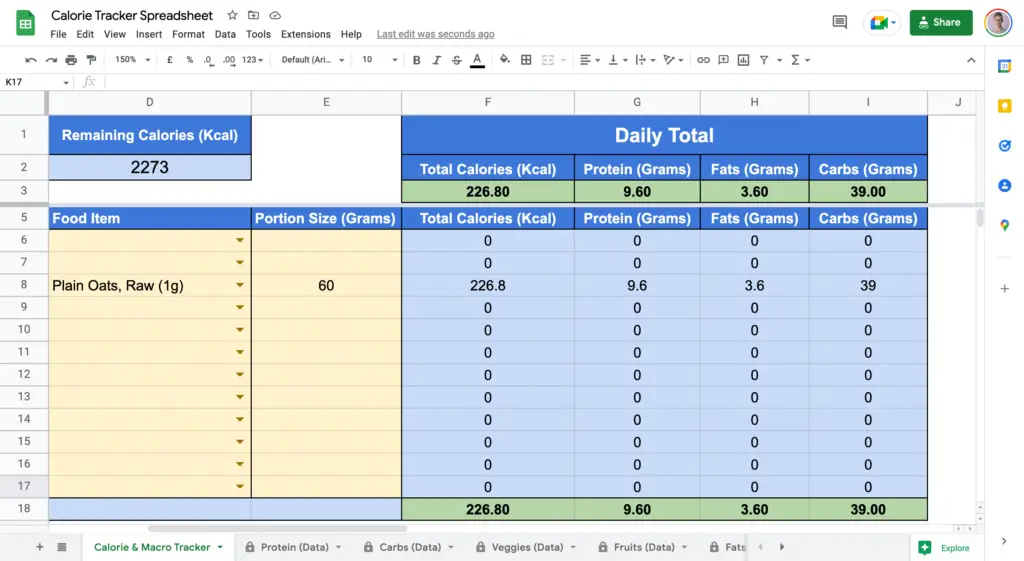
You will need to repeat the process for all the food items in your meal or snack.
Here is what it should look like when I input all the food items for a meal.
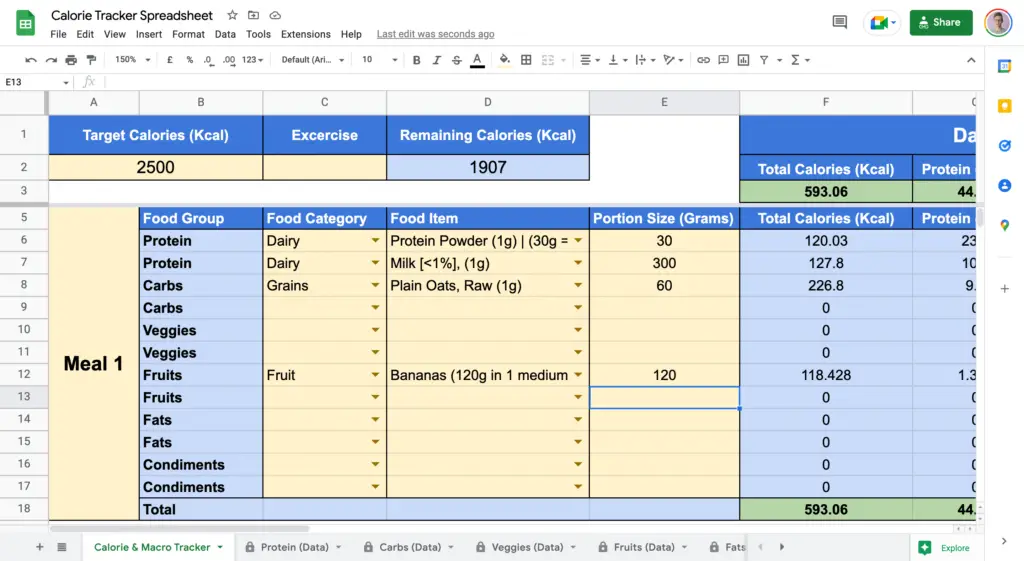
And on the right side, you will see all the nutritional information for that meal.
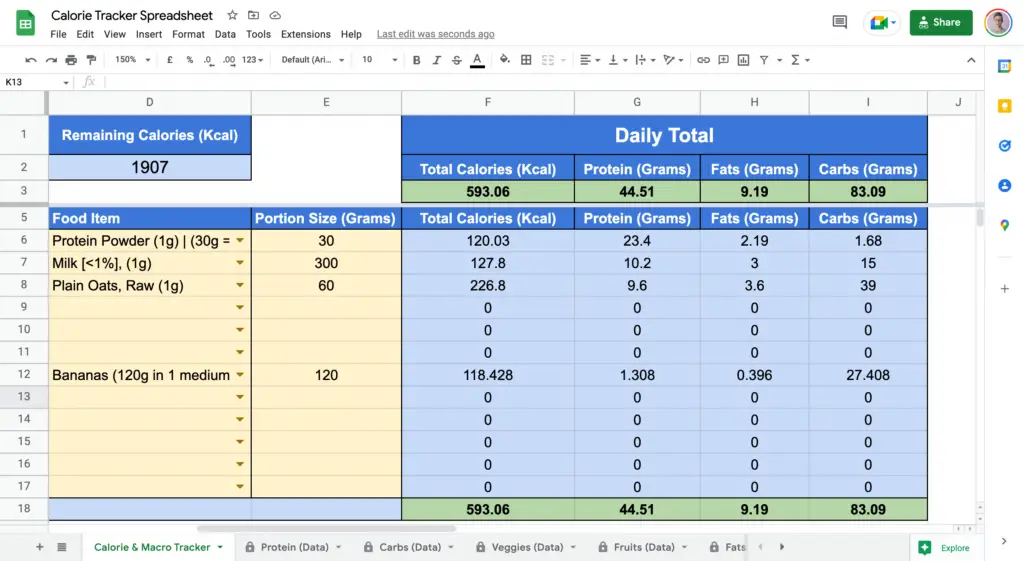
Repeat this process for every meal or snack you want to track the calories for in a single day.
How to Add New Food Items
Sometimes you might want to track calories for a food item that is not already in the spreadsheet.
To do so, you will need to add it to the food database.
NOTE
The food database will get updated periodically with new food items. But if you want to add a new food item right away, here’s how you can do it.
First, go to the relevant sheet that contains (Data) in the sheet name.
On that sheet, you need to find the appropriate food category where you would like to add the new food item. For example, if I want to add popcorn I would have to go to the “Carbs (Data)” sheet and find the “Grains” food category since the food item belongs there.
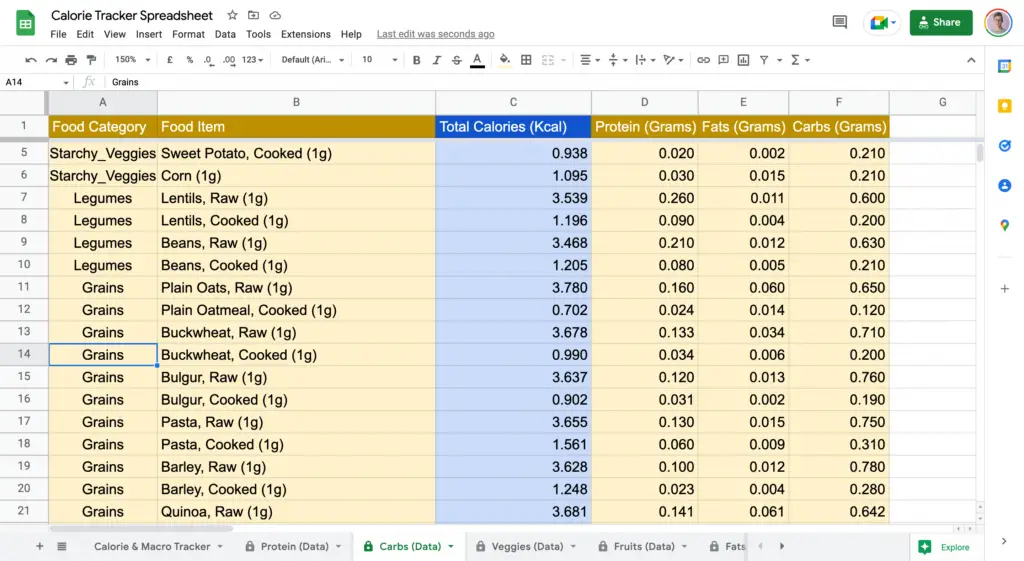
After that, you will have to insert a new row in between the other food items in that food category.

NOTE
It’s important that you insert the new row in between other food items and not at the bottom or above. This is because the drop-down menus are based on a function which looks for the food items in a specific range. If you add a new food item outside that range, the drop-down menus will not work properly.
Once you insert a new row, you will see a warning message. This is because the sheet is protected to prevent the accidental deletion of formulas.

Just ticket the box “Don’t show this again for 5 minutes” and hit OK.
After that you will need to fill in the following information in the new row, under the appropriate columns:
- Write the food category name
- Write the food item name
- Do the data entry for protein, fats, and carbs per 100 grams, and divide it by 100
For instance, 100 grams of unpopped popcorn kernels contain 77.78 grams of carbs, so I will need to input “=77.78/100” in the empty cell under the “Carbs (Grams)” column.
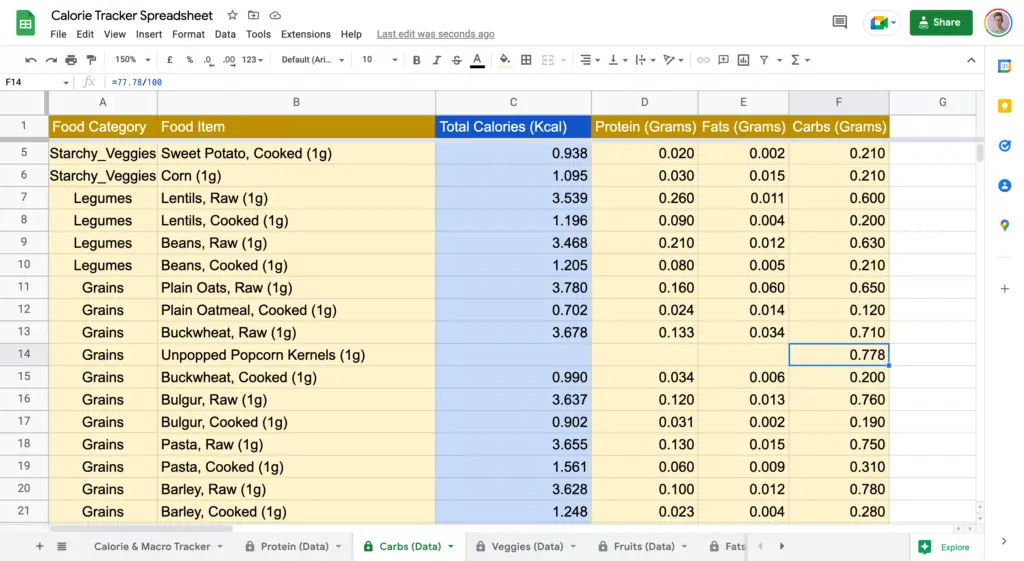
You will then have to repeat this process for the remaining macros – protein and fats. You can find such nutritional information on the internet or food labels.
Finally, you will need to copy/paste the formula in the cell under the “Total Calories (Kcal)” column. You can follow the formula examples on the cells above or below.
Just click on the cell with the formula and hit CTRL+C to copy, then click on the empty cell under the “Total Calories (Kcal)” column and hit CTRL+V to paste. Alternatively, you can hover over the bottom right corner of the cell until you see a black + sign, then click and drag over to the empty cell to apply the formula.
Here is an example of what the formula should look like.
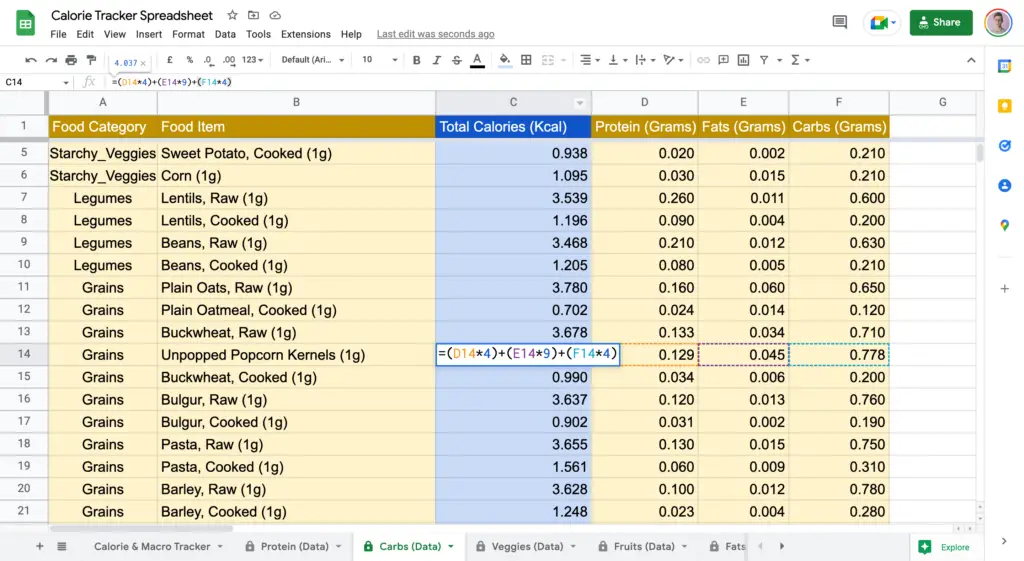
And that’s it! You have successfully added a new food item to the food database. Now you should be able to find it in the drop-down menus.
If you haven’t already got the calorie counter spreadsheet, then you can get it by clicking on the link – get the spreadsheet in Google Sheets.
Frequently Asked Questions About Calorie Counter Tool
How Do I Calculate My Daily Calorie Needs?
To calculate your daily calorie needs, you can either use an online TDEE (total daily energy expenditure) calculator or eat a specific number of calories per day for a few weeks and monitor your weight over time. Once you find a caloric intake that allows you to maintain your current weight, you can conclude these are your daily calorie needs (maintenance calories). If you want to lose weight, you will need to eat below your maintenance calories. And if you want to gain weight, you will need to eat above your maintenance calories.
What is the Easiest Way to Keep Track of Calorie Intake?
The easiest way to track your calorie intake would be to create a meal plan that aligns with your calorie and macro needs depending on your goal and then follow it. This way you calculate everything out once, and then all you need to do is follow your plan.
You can use a calorie and macro tracker spreadsheet (like the one shared in this article) or an app, such as MyFitnessPal to create a meal plan that suits your needs.
How to Track Calories in Google Sheets?
To track calories in Google Sheets, you can use the free calorie tracker shared in this article. This spreadsheet allows you to track your daily calorie intake and see how many calories you have left to eat for the day.
How to Track Calories in Excel?
Unfortunately, the calorie tracker spreadsheet shared in this article is not compatible with Excel, it is only compatible with Google Sheets. I have noted down this task and will try to create an Excel version of the calorie tracker spreadsheet in the future.
Final Thoughts
So, there you have it.
Everything you need to know about calorie counting and how to use a handy calorie counter spreadsheet tool.
If you are looking to also further optimize your shopping I suggest you check out the Google Sheets grocery list template. It’s a great tool to organize your grocery list and more.
I hope this information was helpful and that you are now motivated to start tracking your calories and reach your fitness goals!
If you have any questions or feedback, please don’t hesitate to reach out to me. I am always happy to help and offer support.



![Maingaining: Everything You Should Know [A Step-by-Step Guide]](https://gfitnessonline.com/wp-content/uploads/2022/04/man-lean-muscle.jpg)
